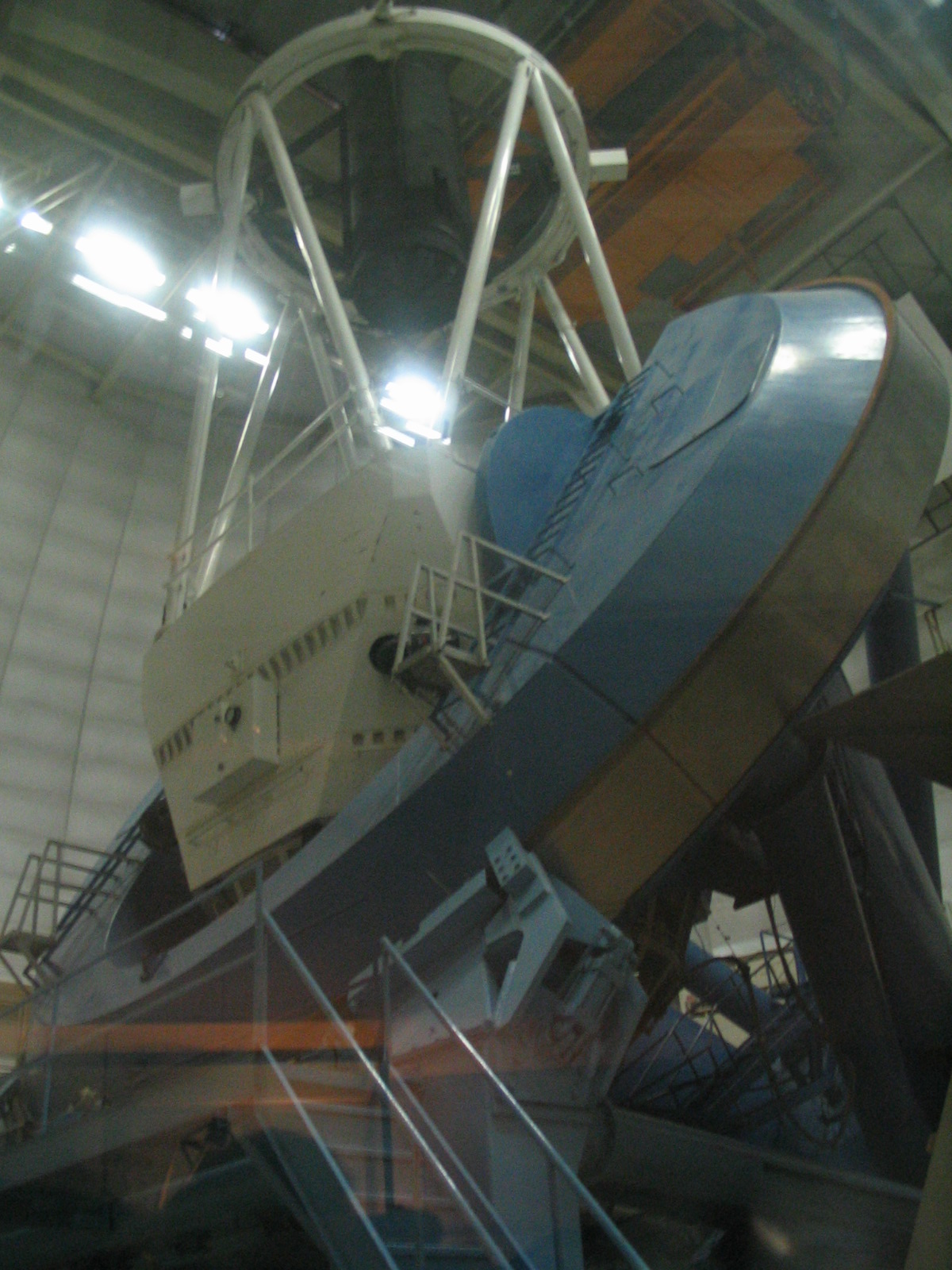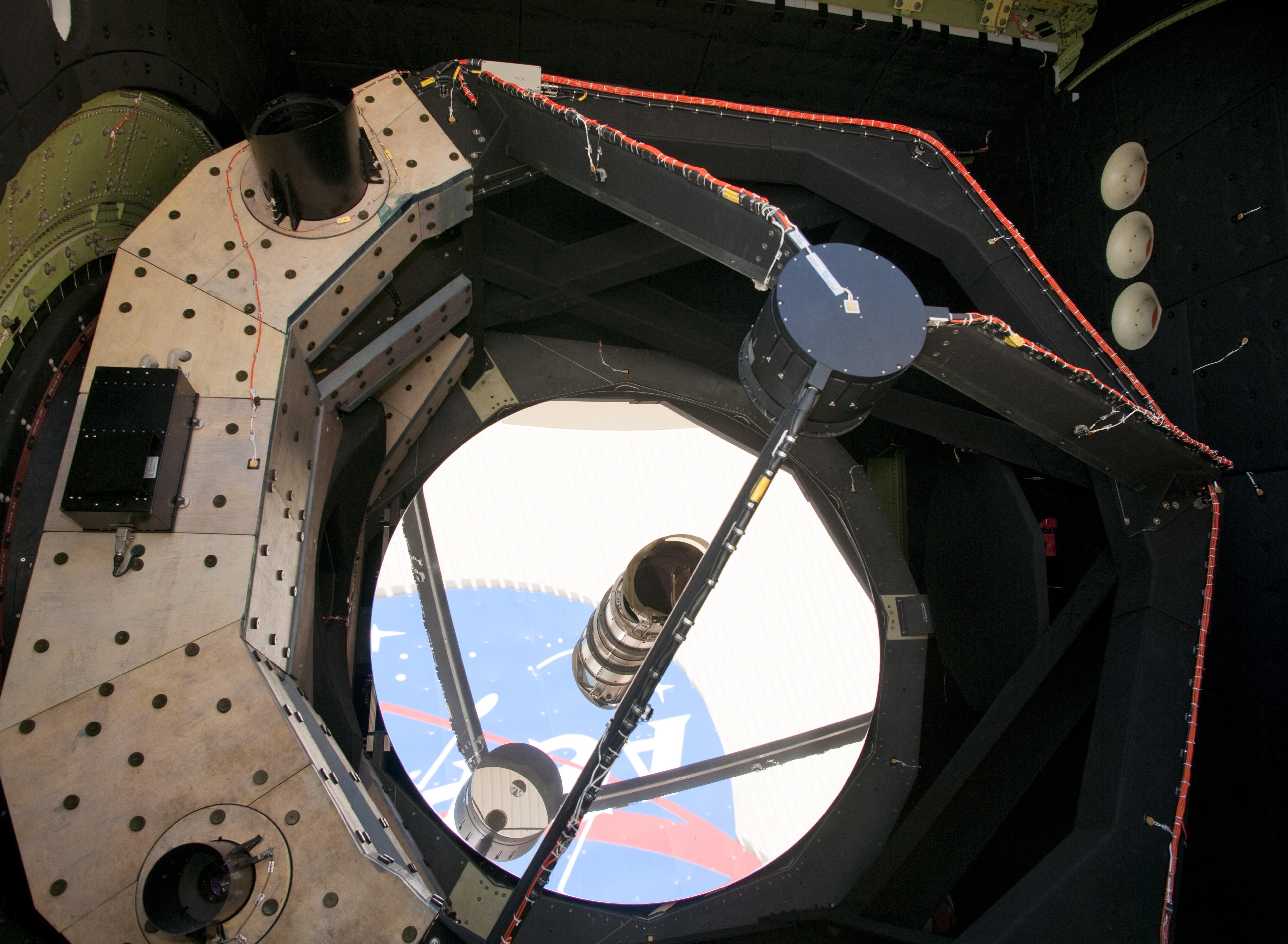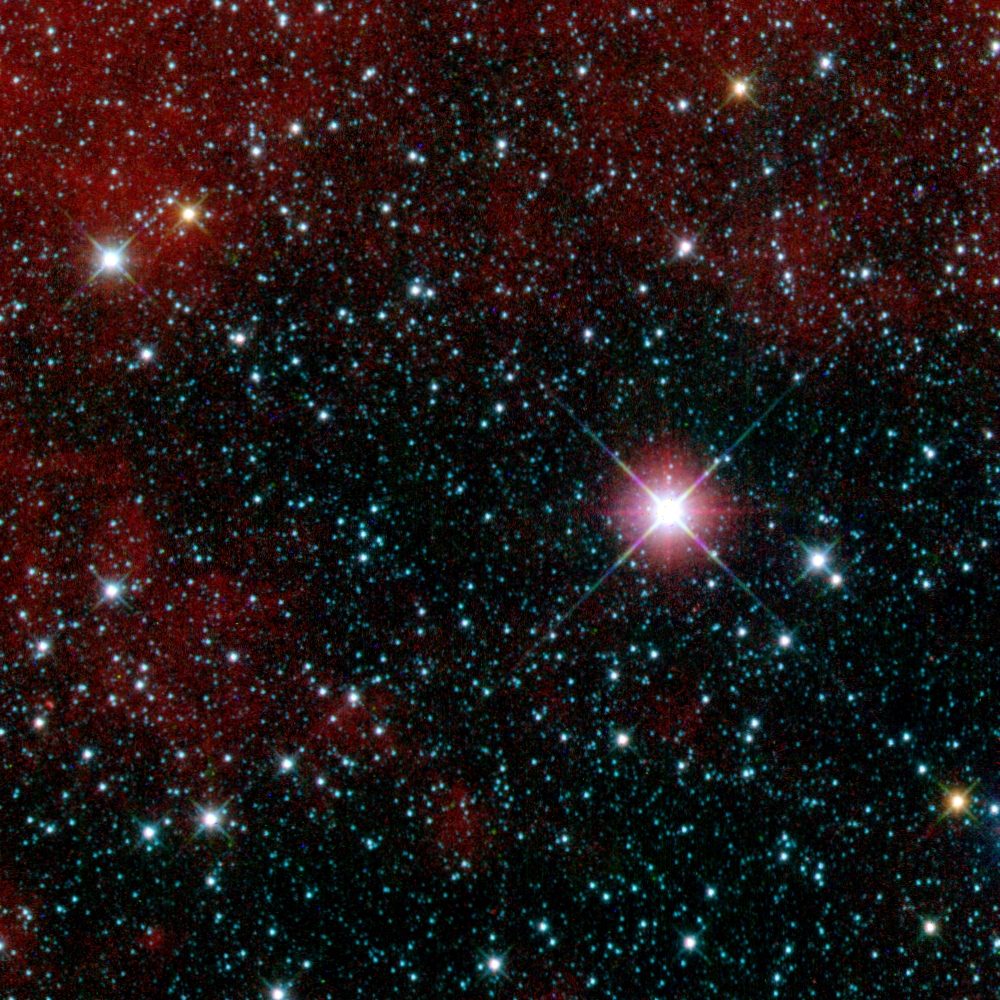|
Observational Astronomy
Observational astronomy is a division of astronomy that is concerned with recording data about the observable universe, in contrast with theoretical astronomy, which is mainly concerned with calculating the measurable implications of physical models. It is the practice and study of observing celestial objects with the use of telescopes and other astronomical instruments. As a science, the study of astronomy is somewhat hindered in that direct experiments with the properties of the distant universe are not possible. However, this is partly compensated by the fact that astronomers have a vast number of visible examples of stellar phenomena that can be examined. This allows for observational data to be plotted on graphs, and general trends recorded. Nearby examples of specific phenomena, such as variable stars, can then be used to infer the behavior of more distant representatives. Those distant yardsticks can then be employed to measure other phenomena in that neighborhood, inc ... [...More Info...] [...Related Items...] OR: [Wikipedia] [Google] [Baidu] |
Mayall Telescope
The Nicholas U. Mayall Telescope, also known as the Mayall 4-meter Telescope, is a four-meter (158 inches) reflector telescope located at the Kitt Peak National Observatory in Arizona and named after Nicholas U. Mayall. It saw first light on February 27, 1973, and was the second-largest telescope in the world at that time. Initial observers included David Crawford, Nicholas Mayall, and Arthur Hoag. It was dedicated on June 20, 1973 after Mayall's retirement as director. The mirror has an f/2.7 hyperboloidal shape. It is made from a two-foot () thick fused quartz disk that is supported in an advanced-design mirror cell. The prime focus has a field of view six times larger than that of the Hale reflector. It is host to the Dark Energy Spectroscopic Instrument. The identical Víctor M. Blanco Telescope was later built at Cerro Tololo Inter-American Observatory, in Chile. Planning & construction In 1961, after work had moved forward on other telescopes, Mayall propose ... [...More Info...] [...Related Items...] OR: [Wikipedia] [Google] [Baidu] |
Electromagnetic Spectrum
The electromagnetic spectrum is the range of frequencies (the spectrum) of electromagnetic radiation and their respective wavelengths and photon energies. The electromagnetic spectrum covers electromagnetic waves with frequencies ranging from below one hertz to above 1025 hertz, corresponding to wavelengths from thousands of kilometers down to a fraction of the size of an atomic nucleus. This frequency range is divided into separate bands, and the electromagnetic waves within each frequency band are called by different names; beginning at the low frequency (long wavelength) end of the spectrum these are: radio waves, microwaves, infrared, visible light, ultraviolet, X-rays, and gamma rays at the high-frequency (short wavelength) end. The electromagnetic waves in each of these bands have different characteristics, such as how they are produced, how they interact with matter, and their practical applications. There is no known limit for long and short wavelengths. Extreme ... [...More Info...] [...Related Items...] OR: [Wikipedia] [Google] [Baidu] |
Visible-light Astronomy
Visible-light astronomy encompasses a wide variety of observations via telescopes that are sensitive in the range of visible light (optical telescopes). Visible-light astronomy is part of optical astronomy, and differs from astronomies based on invisible types of light in the electromagnetic radiation spectrum, such as radio waves, infrared waves, ultraviolet waves, X-ray waves and gamma-ray waves. Visible light ranges from 380 to 750 nanometers in wavelength. Visible-light astronomy has existed as long as people have been looking up at the night sky, although it has since improved in its observational capabilities since the invention of the telescope, which is commonly credited to Hans Lippershey, a German-Dutch spectacle-maker, although Galileo played a large role in the development and creation of telescopes. Visible-light astronomy continues to get better in the modern day, with projects such as the James Webb Space Telescope. Since visible-light astronomy is restricted to ... [...More Info...] [...Related Items...] OR: [Wikipedia] [Google] [Baidu] |
Ultraviolet
Ultraviolet (UV) is a form of electromagnetic radiation with wavelength from 10 nm (with a corresponding frequency around 30 PHz) to 400 nm (750 THz), shorter than that of visible light, but longer than X-rays. UV radiation is present in sunlight, and constitutes about 10% of the total electromagnetic radiation output from the Sun. It is also produced by electric arcs and specialized lights, such as mercury-vapor lamps, tanning lamps, and black lights. Although long-wavelength ultraviolet is not considered an ionizing radiation because its photons lack the energy to ionize atoms, it can cause chemical reactions and causes many substances to glow or fluoresce. Consequently, the chemical and biological effects of UV are greater than simple heating effects, and many practical applications of UV radiation derive from its interactions with organic molecules. Short-wave ultraviolet light damages DNA and sterilizes surfaces with which it comes into contac ... [...More Info...] [...Related Items...] OR: [Wikipedia] [Google] [Baidu] |
Infrared
Infrared (IR), sometimes called infrared light, is electromagnetic radiation (EMR) with wavelengths longer than those of visible light. It is therefore invisible to the human eye. IR is generally understood to encompass wavelengths from around 1 millimeter (300 GHz) to the nominal red edge of the visible spectrum, around 700 nanometers (430 THz). Longer IR wavelengths (30 μm-100 μm) are sometimes included as part of the terahertz radiation range. Almost all black-body radiation from objects near room temperature is at infrared wavelengths. As a form of electromagnetic radiation, IR propagates energy and momentum, exerts radiation pressure, and has properties corresponding to both those of a wave and of a particle, the photon. It was long known that fires emit invisible heat; in 1681 the pioneering experimenter Edme Mariotte showed that glass, though transparent to sunlight, obstructed radiant heat. In 1800 the astronomer Sir William Herschel ... [...More Info...] [...Related Items...] OR: [Wikipedia] [Google] [Baidu] |
Light
Light or visible light is electromagnetic radiation that can be perceived by the human eye. Visible light is usually defined as having wavelengths in the range of 400–700 nanometres (nm), corresponding to frequencies of 750–420 terahertz, between the infrared (with longer wavelengths) and the ultraviolet (with shorter wavelengths). In physics, the term "light" may refer more broadly to electromagnetic radiation of any wavelength, whether visible or not. In this sense, gamma rays, X-rays, microwaves and radio waves are also light. The primary properties of light are intensity, propagation direction, frequency or wavelength spectrum and polarization. Its speed in a vacuum, 299 792 458 metres a second (m/s), is one of the fundamental constants of nature. Like all types of electromagnetic radiation, visible light propagates by massless elementary particles called photons that represents the quanta of electromagnetic field, and can be analyzed as both waves and par ... [...More Info...] [...Related Items...] OR: [Wikipedia] [Google] [Baidu] |
Optical Instrument
An optical instrument (or "optic" for short) is a device that processes light waves (or photons), either to enhance an image for viewing or to analyze and determine their characteristic properties. Common examples include periscopes, microscopes, telescopes, and cameras. Image enhancement The first optical instruments were telescopes used for magnification of distant images, and microscopes used for magnifying very tiny images. Since the days of Galileo and Van Leeuwenhoek, these instruments have been greatly improved and extended into other portions of the electromagnetic spectrum. The binocular device is a generally compact instrument for both eyes designed for mobile use. A camera could be considered a type of optical instrument, with the pinhole camera and camera obscura being very simple examples of such devices. Analysis Another class of optical instrument is used to analyze the properties of light or optical materials. They include: *Interferometer for measuring th ... [...More Info...] [...Related Items...] OR: [Wikipedia] [Google] [Baidu] |
Optical Astronomy
Visible-light astronomy encompasses a wide variety of observations via telescopes that are sensitive in the range of visible light (optical telescopes). Visible-light astronomy is part of optical astronomy, and differs from astronomies based on invisible types of light in the electromagnetic radiation spectrum, such as radio waves, infrared waves, ultraviolet waves, X-ray waves and gamma-ray waves. Visible light ranges from 380 to 750 nanometers in wavelength. Visible-light astronomy has existed as long as people have been looking up at the night sky, although it has since improved in its observational capabilities since the invention of the telescope, which is commonly credited to Hans Lippershey, a German-Dutch spectacle-maker, although Galileo played a large role in the development and creation of telescopes. Visible-light astronomy continues to get better in the modern day, with projects such as the James Webb Space Telescope. Since visible-light astronomy is restricted t ... [...More Info...] [...Related Items...] OR: [Wikipedia] [Google] [Baidu] |
Reflecting Telescope
A reflecting telescope (also called a reflector) is a telescope that uses a single or a combination of curved mirrors that reflect light and form an image. The reflecting telescope was invented in the 17th century by Isaac Newton as an alternative to the refracting telescope which, at that time, was a design that suffered from severe chromatic aberration. Although reflecting telescopes produce other types of optical aberrations, it is a design that allows for very large diameter objectives. Almost all of the major telescopes used in astronomy research are reflectors. Many variant forms are in use and some employ extra optical elements to improve image quality or place the image in a mechanically advantageous position. Since reflecting telescopes use mirrors, the design is sometimes referred to as a catoptric telescope. From the time of Newton to the 1800s, the mirror itself was made of metal usually speculum metal. This type included Newton's first designs and even the larges ... [...More Info...] [...Related Items...] OR: [Wikipedia] [Google] [Baidu] |
Infrared Radiation
Infrared (IR), sometimes called infrared light, is electromagnetic radiation (EMR) with wavelengths longer than those of visible light. It is therefore invisible to the human eye. IR is generally understood to encompass wavelengths from around 1 millimeter (300 GHz) to the nominal red edge of the visible spectrum, around 700 nanometers (430 THz). Longer IR wavelengths (30 μm-100 μm) are sometimes included as part of the terahertz radiation range. Almost all black-body radiation from objects near room temperature is at infrared wavelengths. As a form of electromagnetic radiation, IR propagates energy and momentum, exerts radiation pressure, and has properties corresponding to both those of a wave and of a particle, the photon. It was long known that fires emit invisible heat; in 1681 the pioneering experimenter Edme Mariotte showed that glass, though transparent to sunlight, obstructed radiant heat. In 1800 the astronomer Sir William Herschel discovered ... [...More Info...] [...Related Items...] OR: [Wikipedia] [Google] [Baidu] |
Infrared Astronomy
Infrared astronomy is a sub-discipline of astronomy which specializes in the observation and analysis of astronomical objects using infrared (IR) radiation. The wavelength of infrared light ranges from 0.75 to 300 micrometers, and falls in between visible radiation, which ranges from 380 to 750 nanometers, and submillimeter waves. Infrared astronomy began in the 1830s, a few decades after the discovery of infrared light by William Herschel in 1800. Early progress was limited, and it was not until the early 20th century that conclusive detections of astronomical objects other than the Sun and Moon were made in infrared light. After a number of discoveries were made in the 1950s and 1960s in radio astronomy, astronomers realized the information available outside the visible wavelength range, and modern infrared astronomy was established. Infrared and optical astronomy are often practiced using the same telescopes, as the same mirrors or lenses are usually effective over a wavel ... [...More Info...] [...Related Items...] OR: [Wikipedia] [Google] [Baidu] |
Radio Telescope
A radio telescope is a specialized antenna and radio receiver used to detect radio waves from astronomical radio sources in the sky. Radio telescopes are the main observing instrument used in radio astronomy, which studies the radio frequency portion of the electromagnetic spectrum emitted by astronomical objects, just as optical telescopes are the main observing instrument used in traditional optical astronomy which studies the light wave portion of the spectrum coming from astronomical objects. Unlike optical telescopes, radio telescopes can be used in the daytime as well as at night. Since astronomical radio sources such as planets, stars, nebulas and galaxies are very far away, the radio waves coming from them are extremely weak, so radio telescopes require very large antennas to collect enough radio energy to study them, and extremely sensitive receiving equipment. Radio telescopes are typically large parabolic ("dish") antennas similar to those employed in trackin ... [...More Info...] [...Related Items...] OR: [Wikipedia] [Google] [Baidu] |



.jpg)





